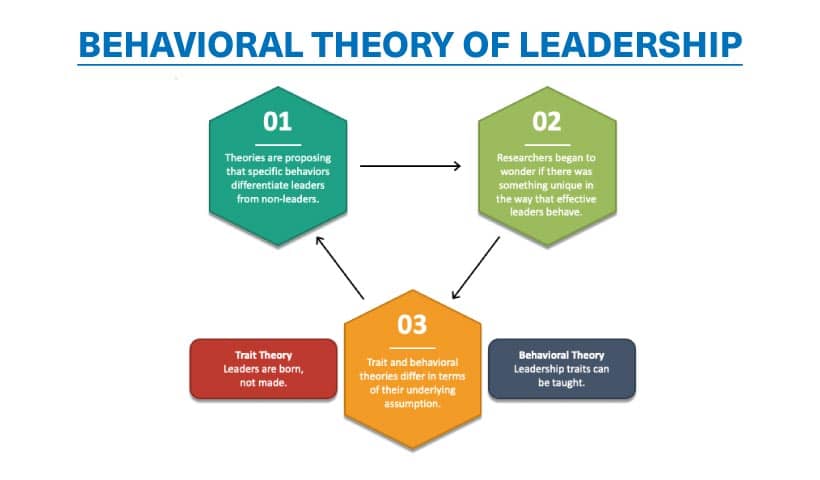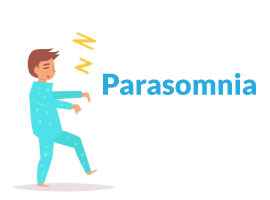Do you think that behavioral leadership theory contains authority to show the right path.? If so, what would it be accrual impact of it? Well, our intent here is to explore this theory thoroughly. The road of leadership, somehow, seems to be complex and rigid. Many researchers have initiated several aspects to determine the exact facts to work on it.
In this continuation, we explore that behavioral traits can impact the leadership style highly. Truly, the traits are severely influential. Therefore, this theory is a field of study that investigates how people lead to altering the behavior of others. It raises questions about the crucial part of leadership. In the next phases, we will elaborate on those parts to explore the apt answers. Besides, this article will deliver you a brief introduction to this leadership theory.
Behavioral Leadership Theory
This theory is a relatively new field that tries to understand how people behave when they are in charge. By applying to the corporate world, this theory tries to explain how leaders can create an environment. It is such a circumstance where employees are motivated and inspired to do their best work. In this case, leaders need to understand how people think and act.

In addition, leaders must comprehend how people use the knowledge to create an environment that encourages success. Thus, a leader creates the pathway for the organization to achieve its goal. You know what; it is the latest breakthrough in management theory that has revolutionized the leader’s managerial capabilities. It creates belief among the leaders that their leadership style is effective.
On the other hand, it is a comprehensive model. Usually, it offers an understanding of how the behavioral intentions and actions of leaders affect followers. By understanding this, leaders can craft specific plans and strategies to create a positive impact on organizational performance.
Significantly, it contains five core concepts. These concepts are intention, goal setting, communication, reinforcement, and motivation. By understanding the various aspects of behavioral leadership theory, you can improve your ability to lead people. In fact, this theory shows a core way that achieves desired outcomes.
Behavioral Leadership Theory Examples
Certainly, behavioral leadership is a tactic that emphasizes changing employee behavior for the better. The theory suggests that leaders should focus on four key behaviors that will help their teams achieve success. For instance, we can name autonomy, empathy, consistency, and input from all members of the team.
Here, the leaders should manage these behaviors through a variety of methods to create an effective workplace culture. By setting the example for good behavior and using constructive feedback, leaders can help their teams reach their full potential.
When it comes to this theory, two main styles can be perfect examples.
In fact, the behavioral leadership theory is the apt orientation of task-oriented leaders and people-oriented leaders. Firstly, task-oriented leaders focus on the task at hand and how to complete it as efficiently as possible. People-oriented leaders, on the other hand, are more fretful with the people under them and their well-being.
These leaders tend to be more emotionally open and are better at building hope and relationships. Besides, they also have a better understanding of people's needs and are better at handling grim situations. Therefore, this theory is a field that looks at how leaders can create a milieu that boosts employee productivity.
Behavioral Leadership Theory Strengths and Weaknesses
This theory presents a popular leadership model. It works on the premise that leaders influence their followers through behavioral attributes. According to this theory, it is the behavioral aspects of leaders rather than their cognitive or technical abilities. After that, these things determine how successful they will be in leading their followers.
Leaders need to use positive reinforcement and demonstration of leadership behaviors. Besides, it should have vibrant expectations to inspire good behavior from its subordinates. The theory suggests that its strengths and weaknesses can have a significant impact on its followers. In this blog, we will be conversing about some of the strengths and weaknesses of this theory.
Strengths:
• Key Leadership Model:
Firstly, it is a core model of leadership that emphasizes understanding people's motivations and behaviors. In this way, the leaders arouse employees to act for the best welfare of the organization. Besides, this theory helps leaders to identify and address key issues that can impact employee performance.
The crucial benefits of behavioral leadership include improved morale, increased creativity, and strengthening teamwork. You know what; this leadership model is the practice of embedding leadership behaviors into an organization’s culture. Here, it crafts a workplace where employees feel driven and enthused about acting effectively.
• Personal Attributes Booster:
This leadership theory is a great way to enrich personal attributes. It delivers the chances to develop one's aptitudes, form trust, and craft a sense of camaraderie. Here, leaders must be good hearers and have the ability to read people well.
Besides, they must also be able to empathize with them and be able to set clear boundaries.It is an approach that highlights altering the behavior of employees instead of just their attitudes. Additionally, it enriches personal attributes such as creativity, innovation, and teamwork. Through the actual behavioral leadership model, companies can attain better customer service, amplified profitability, and greater employee satisfaction.
• Ethical Working Mood:
Behavioral leadership theory is one of the most persuasive concepts in leadership today. In it, leaders eye on the ethical working process to form a milieu that is conducive to high-performance and ingenuity. Leaders who are effective in behavioral leadership create an ethical culture.
They do it by establishing clear limits of prospects, setting clear goals and objectives, and providing clear feedback. You know what; leaders who focus on the ethical working process are able to foster creativity. Besides, they craft an environment that is open and supportive. Ethics has always been one of the most important elements in behavioral leadership. Here, leaders have the dedication to upholding the highest ethical standards.
• Effective Decision Making:
This theory teaches a leader to make an apt decision. In this case, a leader evaluates the pros and cons of a decision and picks the option that will yield the best outcomes. It is a cognitive process that begins with recognizing an unruly. After that, the leader proceeds to form a plan of action in order to solve it.
The best part about decision-making is that anyone can learn and apply the process accurately. Here, the leaders are very active and amazing in making a decision. Thus, they can lead the whole team and organization to achieve uttermost success. In fact, it is really an apt strength of this theory.
• Nurtures Connection And Belonging:
Lastly, this leadership style is all about nurturing connection and belonging within an organization. It is not only about creating a deep and fuzzy workplace but also about making employees feel valued for their contributions. You know what; people are social animals. They crave connection and belonging.
Usually, they need to feel a sense of being a part of something larger than them. That is why; it is so didactic for leaders to nurture a connection with their team members. Leaders who connect with their team members emotionally and spiritually are able to lead them in the right direction.
Weakness:
• Poor Control Over Tough Situations:
We can name many aspects where behavioral leadership style can be highly fruitful. In some cases, we may explore some flaws and limitations of this leadership model. Truly, this style of leadership is not very effective when the situation gets out of control. It is because; most behavioral leaders count on their emotions rather than their logic to make decisions.
As a result, they end up crafting decisions that are not in the best interest of their team or organization. For being an effective behavioral leader, you need to learn how to use your emotions. Thus, controlling emotion can enrich your efficacy in controlling the tough situation. After that, it will be beneficial to you and your team.
• Stagnancy:
Behavioral leadership is a rapidly growing field that focuses on how people can be managed to raise their effectiveness. But, the majority of people are stuck in a cycle of stagnation. It is really a major weakness of behavioral leadership. When folks are stuck in a crater, they are not able to capitalize on opportunities and grow. Thus, it ultimately decreases their ability to lead.
If you want to be a successful behavioral leader, you need to catch ways to break free from stagnation. You may grab many ways to do this thing for the betterment of the organization. But, the most important thing is to stay flexible and constantly learn. Consequently, the leaders can ensure utter success for the business organization.
• Fail to Levy Vibrant Expectations:
Many times, behavioral leadership usually fails to levy vibrant expectations for employees and managers alike. In fact, it can lead to confusion, lack of trust, and disengagement. It occurs when leaders do not give clear instructions, establish clear roles and responsibilities. Besides, man does not hold people accountable for their actions.
Because of these things, employees are reluctant to take any action and instead wait for instructions that never come. Additionally, these leaders often resort to unprofessional behaviors to get their point across. It often backfires as it makes people dislike them even more. Therefore, the organization usually does not get optimal output from the employees.
Behavioral Leadership Theory Pros and Cons
We all know that it is one of the most popular theories in business today. Proponents of this theory believe that effective leaders can be identified by their behavioral patterns and how they manage people. On the other hand, detractors argue that this theory does not take into account individual differences. Which side are you on this issue? Well, you must explore every side of this theory before deciding.
Firstly, let's have a clear view of the pros of this leadership theory. You know what; people are more likely to recall and act on information. It happens when they feel they have ownership of it. This thing can come through behavioral leadership. In fact, it is the teaching strategy that emphasizes the importance of engagement, feedback, and reflection.
Behavioral leadership crafts a collaborative milieu by building trust and understanding between the leader and the learners. In this situation, employees feel comfortable sharing their thoughts and ideas. Besides, it also provides a platform for leaders to offer timely feedback, support, and guidance, leading to the amended recital.
Secondly, this leadership covers the route of mounting and applying an actual system for managing people. Besides, you must craft this system to elicit desired behaviors from individuals and groups. In fact, you can do it by influencing their emotions, cognitions, and behaviors. Well, this system encourages people to behave in a certain way.
Therefore, it is imperative that the leader behaves in a way that allows for behavioral leadership to flourish. If these things come true, then the organization will easily run towards profitability. Additionally, the productive mood of the working process will accelerate the success rate as well.
On the other hand, we may explore the adverse side of the behavioral leadership theory. In fact, certain aspects of behavioral leadership may seem to be immoral in many senses. These aspects include manipulating people's emotions and coercing them into doing what they want. In this way, this leadership model levies bad instances for the team.
Behavioral Leadership Examples
Most importantly, the behavioral leadership model can be applicable at all levels of an organization. From the CEO to the downsized varlet, this style will be highly effective and optimal. You know what; this style of leadership picks the points on the behavior of individuals and groups. Conversely, it denies the traditional methods such as charisma, doctrine, or political power.
Here, we can eye at some great leaders who are the perfect example of behavioral leadership. Firstly, we can name Reed Hastings, the founder and CEO of Netflix. He is a great behavioral leader. In fact, he has a clear vision for his company and sticks to it even when things get tough. As a behavioral leader, he also has a clear strategy for growing his company.
The second name that rolls up on our list is Bob IGER, the current Chairman and CEO of the Walt Disney Company. You know what; he is widely familiar as one of the best behavioral leaders in the world. His strategies play a major role in shaping the behaviors of his employees. Besides, the prime efficacy of this leader is to foster teamwork and communication.
Conclusion
At this point, we can verily embroil that you have grabbed a proper view of the behavioral leadership theory. Actually, it is one of the most exigent tools for any businessperson. We believe it is all about holding and managing people and their emotions to create a successful workplace. The leaders must have mindful of the behaviors that impact productivity and team morale.
By instilling a set of principles, you can enrich the chances of achieving the goal. This leadership involves many different skills, all of which must come if you want to be a successful leader. In this way, the behavioral leadership model can be highly fruitful for the team and organizations.








